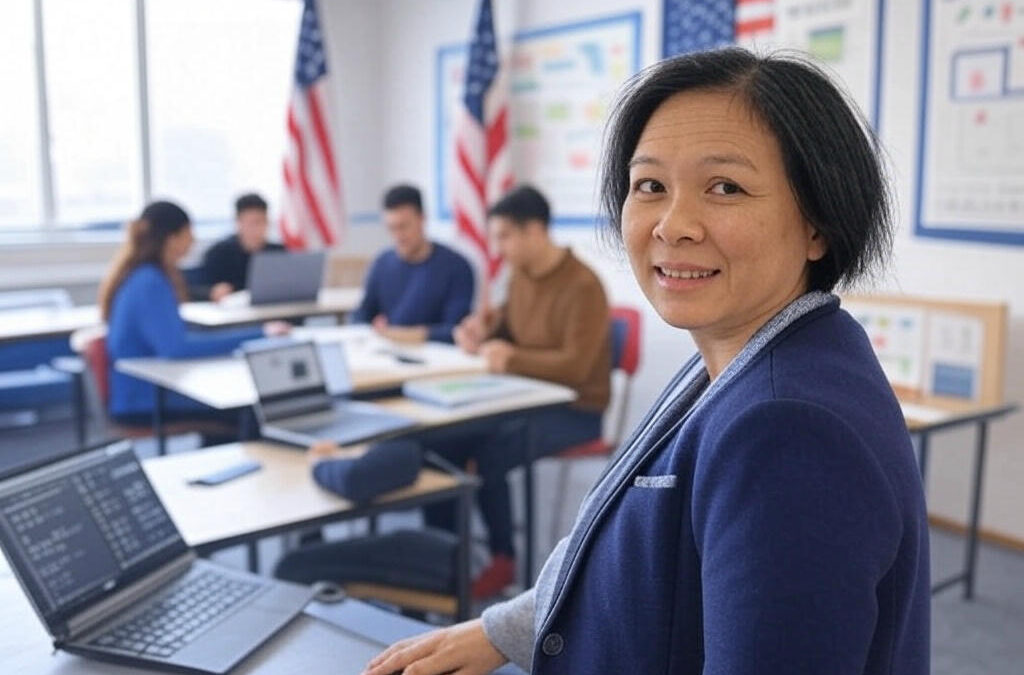The hybrid classroom—where learning toggles between in-person and virtual spaces—has redefined education over the past few years. As a content writer with a decade of experience tracking educational shifts, I’ve seen how this model demands adaptability, especially from educators. Teacher Hybrid Classroom Training is now essential, and for educational consultants, the mission is clear: equip teachers with the skills to excel in this dual-mode world.
In this guide, we’ll explore the best practices, engagement strategies, and technology training to ensure successful hybrid teaching.
Understanding the Hybrid Teaching Landscape
Hybrid teaching means managing two audiences at once: students in the room and those online. A 2023 study from the National Center for Education Statistics revealed that many educators feel stretched thin by this setup.
Actionable Tip: Educational consultants should kick off Teacher Hybrid Classroom Training with diagnostic assessments, such as surveys or small-group discussions, to uncover specific needs like mastering virtual tools or keeping remote learners engaged.
Building a Strong Foundation with Tech Training
Technology is the backbone of hybrid learning, but many teachers struggle with tools like Zoom, Google Classroom, or Microsoft Teams.
Key Tech Areas to Cover in Training:
✔ Screen-sharing & virtual whiteboards
✔ Breakout rooms & student collaboration tools
✔ Handling connectivity issues & troubleshooting
For example, Common Sense Education’s Zoom tutorial offers a beginner-friendly guide that consultants can integrate into training.
Mastering Dual-Mode Engagement
- Keeping students engaged in-person and online simultaneously is one of the biggest hybrid teaching challenges.
- Top Engagement Strategies:
- Use interactive tools like Kahoot, Padlet, and Nearpod to sync activities across in-person and virtual learners.
- Encourage live discussions with real-time polls and breakout groups.
- Ensure equitable participation by alternating between online and in-person students.
- Kendra Simms specializes in hybrid engagement strategies, helping teachers implement interactive techniques that unify both learning environments.
Structuring Lessons for Hybrid Flexibility
Hybrid learning requires lesson structures that work across both formats. One effective approach is the Flipped Classroom Model, where students watch pre-recorded lectures at home and engage in discussions during class.
🔹 Tip: Break lessons into 10-15-minute segments to maintain student attention across both modalities.
A study from The Journal of Educational Technology & Society found that hybrid classrooms using flipped models saw a 20% increase in student engagement.
Fostering Collaboration & Community in Hybrid Classrooms
A major challenge in Teacher Hybrid Classroom Training is preventing remote students from feeling isolated.
Ways to Bridge the Gap:
✔ Pair in-person and remote students for group projects.
✔ Use discussion forums & peer feedback systems to build relationships.
✔ Encourage collaborative assignments using Google Docs or Jamboard.
Kendra Simms emphasizes community-building as a key pillar of hybrid classroom success.
Ongoing Support and Reflection
Teacher Hybrid Classroom training isn’t a one-and-done deal. Consultants must establish follow-up mechanisms—monthly check-ins or peer observation groups—where teachers can share wins and troubleshoot challenges. Encourage reflective practices, like journaling or debriefing after lessons, to refine their hybrid skills. Resources like the American Educational Research Association offer templates for such reflection, which consultants can adapt.
The Consultant’s Impact
When teachers master hybrid classrooms, they create dynamic learning spaces that defy physical boundaries. Consultants who deliver tech mastery, engagement tactics, and flexible plans spark this transformation. After 10 years of writing about education, I’m convinced: Teacher Hybrid Classroom training is a chance to innovate. With the right playbook, consultants can ensure that educators seize it.
Ready to dive deeper? Explore more strategies with Kendra Simms, where evidence-based solutions meet real-world impact.
FAQ
1. What is hybrid classroom training, and why is it important?
Hybrid classroom training equips teachers to manage both in-person and virtual students effectively. It’s vital because modern education blends physical and digital spaces, requiring skills in tech and engagement. Kendra Simms emphasizes that without this training, teachers risk leaving learners disconnected, pushing for strategies that unite these environments.
2. How can teachers overcome technology challenges in hybrid settings?
Teachers often struggle with tools like Zoom or Google Classroom, but targeted training helps. Kendra Simms recommends hands-on workshops where educators practice real scenarios—like fixing audio issues or setting up breakout rooms—to build confidence and shift focus back to teaching.
3. What are the best ways to engage both in-person and online students?
Engagement in hybrid classrooms relies on inclusive tools and tactics. Kendra Simms suggests platforms like Padlet or Kahoot to sync activities across groups, ensuring everyone participates. She trains teachers to balance live discussions with virtual input seamlessly.
4. How should lesson plans differ for hybrid teaching?
Hybrid lesson plans need adaptability—short, modular segments that work in both settings. Kendra Simms advocates for the flipped classroom model, where students prep online and engage actively in class, keeping lessons dynamic across modalities.
5. How can teachers build community in a hybrid classroom?
Remote students can feel isolated, but collaboration fixes that. Kendra Simms’ approach involves pairing in-person and online learners for projects, fostering connection, and creating a unified classroom vibe, no matter the location.
6. What kind of ongoing support do teachers need after training?
One-time training isn’t enough—teachers need continuous growth. Kendra Simms recommends follow-ups like peer coaching or monthly check-ins, where educators refine their skills and adapt to hybrid demands over time.
7. How do consultants like Kendra Simms make a difference in hybrid education?
Consultants bridge theory and practice. Kendra Simms stands out by offering evidence-based, customized training that empowers teachers to master hybrid classrooms, transforming schools into dynamic learning hubs. Learn more at Kendra Simms.
